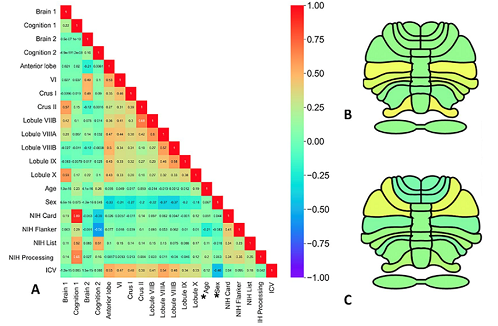CEREBELLUM STRUCTURE AND COGNITIVE FUNCTION
Located at the bottom and back of the brain, the cerebellum is an essential region for controlling motor function, and is now also known to contribute to higher cognitive functions, including social behavior. It is involved in a wide range of functions such as working memory, language processing and general intelligence. However, the association between the structural anatomy of the cerebellum and cognitive functions remains relatively unexplored. In a previous publication, the NeuroSpin team highlighted a complex relationship between the structure of certain areas of the cerebellum and social communication skills in young subjects from the American Healthy Brain Network (HBN) cohort with autism-related symptoms (see Joliot news).
MULTIVARIATE STATISTICS ON A LARGE TRANSDIAGNOSTIC SAMPLE
In the present work, the team studied how the main anatomical subdivisions (lobules) of the cerebellum were associated with different cognitive domains by analyzing data from 662 participants included in the HBN cohort and taking into account the effect of age, gender or even the subjects' symptoms. To do this, the researchers used a multivariate canonical correlation analysis (CCA) model to assess the association between cerebellar anatomy and cognitive phenotype. They also performed permutation tests to ensure the robustness of their results. This work highlights a complex association between cognitive flexibility, processing speed and working memory, on one hand, and lobules of the cerebellum known to be involved in cognitive tasks, in particular the hemispheric part of lobule VII, known as Crus 2, which is thought to be assigned to the treatment of language processes, on the other hand.

The "functional mapping" proposed here, establishing a link between cerebellar anatomy and major cognitive functions, should provide a better understanding of the cerebellum's contribution to psychiatric pathologies. The team is currently working on non-invasive brain stimulation methods to improve cognitive impairment in patients suffering from schizophrenia.
Contact : Charles Laidi (charles.laidi@cea.fr or charles.laidi@aphp.fr)
- Over the last few decades, research has accumulated in support of the "
transdiagnostic" approach, i.e. that many
psychiatric diagnoses share fundamental underlying vulnerabilities. This has led to the development of so-called "transdiagnostic" interventions aimed at treating underlying vulnerabilities rather than a disorder
- The
Healthy Brain Network (HBN), a cohort initiated in 2015 in New York, is one of the largest and most comprehensive neuroscientific datasets dedicated to the
mental health of children and adolescents. It will ultimately bring together data from over 10,000 subjects aged 5 to 21 whose parents were concerned about potential psychiatric problems.
https://healthybrainnetwork.org/